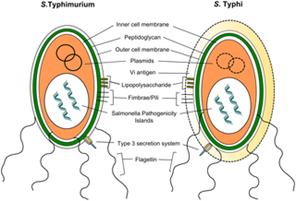BY: SREELAKSHMI (MSIWM012)
Salmonellas is an infectious disease caused by bacteria. It is also known as salmonellosis. Causes Enteric fever, Gastroenteritis, Septicaemia etc. Salmonella typhi rank Typhoid. Salmonella is two groups that include a group that includes the enteric flu that contains only typhoid & Paratyphoid bacilli or major human parasites and the other group includes a group that causes food poisoning but can infect people who cause stomach infections.

Causes: Often the cause of contaminated food or water. Food delivery can enter
• Raw meat, poultry and seafood: Sewage enters immature meat and poultry causes contamination and disease. The transport of marine fish can be caused by water pollution in the agricultural environment.
• Raw Eggs: some infected chickens produce salmonella-containing eggs before the shell is formed. Raw eggs are used as versions of mayonnaise and hollandaise sauce.
• Fruits and vegetables: New products like imported varieties, can be watered or washed during salmonella contamination. Contamination may also occur in the kitchen, where juice from raw meat and poultry comes in contact with uncooked food.
The Food and Drug Administration claims that some outbreaks of salmonella have been caused by spice contamination. Food can also be contaminated if it is prepared by people who do not wash their hands properly after using the toilet or changing diapers. Infection can occur if you touch anything contaminated including pets, birds and reptiles and put your fingers in your mouth.
Salmonella are negative gram sticks. With the exception of S. gallinarum pullorum they travel with peritrichate flagella. Salmonellae is an aerobic plant that grows in light media at a pH between 6-8 and a temperature of 15-41 ° C. They can be killed at 55oC for one hour or 60oC for 15 minutes. Boiling or dehydrating and dehydrating helps to eliminate bacilli. In dirty water it can live for weeks and freeze for months.
Salmonella infection is not a life-threatening disease. In some cases, especially when infants and young children, elderly adults, transplants, pregnant women, and people with weakened immune systems find this infection can be difficult.
It can be dangerous. It causes dehydration as you get diarrhoea and do not take a sufficient amount of water to compensate for water loss. Warning signs include reduced urine, dry mouth, sunken eyes, and decreased production of tears.
When salmonella infection enters the bloodstream, it can cause tissue damage throughout the body. When it affects the tissues around your brain and spinal cord it can lead to meningitis. If you have a heart attack or valve, it could be endocarditis.
Infections in the bones or bone marrow can cause osteomyelitis. People who have been infected with salmonella are at greater risk of developing active arthritis. Also known as Reiter’s syndrome.
Active rheumatoid arthritis is the cause: Eye irritation, painful urination, painful joints Prevention can be done with care to avoid spreading the virus to others. Immunizations are really important when preparing food, caring for infants, the elderly and people with weakened immune systems. Washing hands thoroughly can help prevent the transmission of salmonella virus to your mouth from any food you prepare.
Salmonellae causes the following clinical disease in humans
Enteric fever
It is also called typhoid fever. It is usually caused by Salmonella enteric serotype typhi and S. enteric serotypes paratyphi A, B, and C.
They are phagocytosed by polymorphs and macrophages. They are able to withstand intercellular killings and multiply within cells. They enter the lymph nodes where they multiply .They enter the bloodstream through the thoracic tunnel causing bacteraemia.
Bacillus is more abundant in the bladder as bile is a good culture. It is then continuously excreted in the intestine where it implants Peyer’s Patches and lymphoid follicles on the ileum, which is ulcerative and can lead to intestinal insufficiency & bleeding as a problem.
The incubation period is usually 7-14 days but may occur in 3-56 days. Bacteraemia occurs early in the disease and blood pressure is very good in the first week of the flu. The diagnosis is collected about 5-10ml of blood and injected into a traditional bottle containing 50-100ml of 0.5 per cent of bile broth.
The sample was incubated overnight at 37oC. After that bile broth is a subculture in MacConkey agar, pale lactose fermenting colonies from this method were selected for chemical experiments. Salmonellae is usually motile, indole and urease non-fertile glucose and ferment. Another option is the display of typhoid bacilli in the blood or urine.
If Salmonellae is not found in the original small cultures, the smaller cultures should be repeated every other day until growth is achieved. If possible, if Salmonellae cannot be detected in the first subculture from the broth, subcultures should be repeated daily until growth is achieved.
